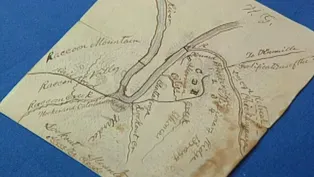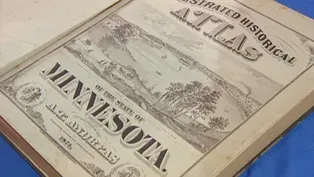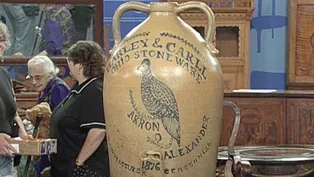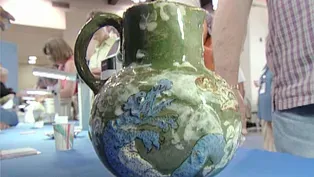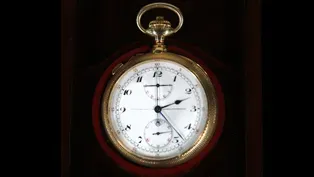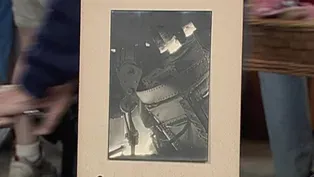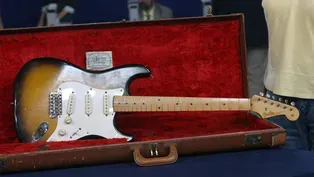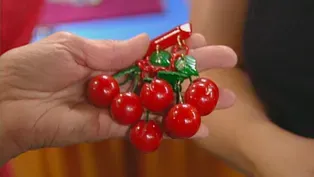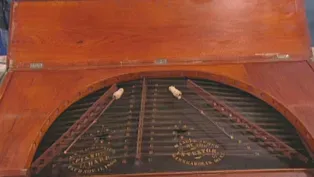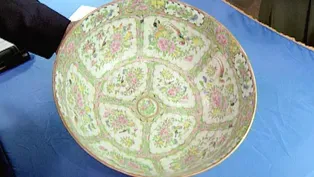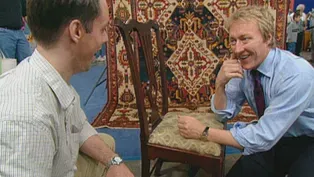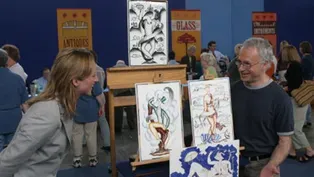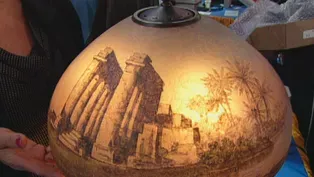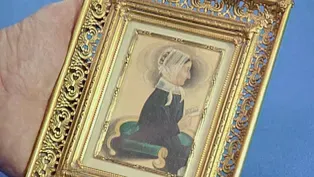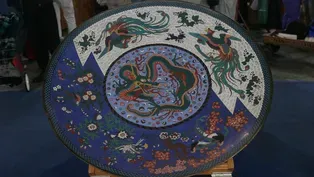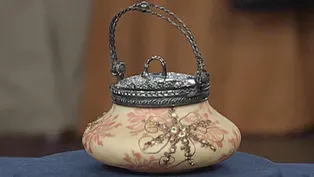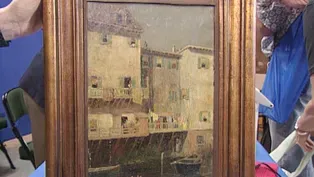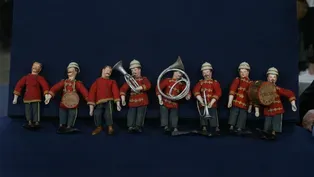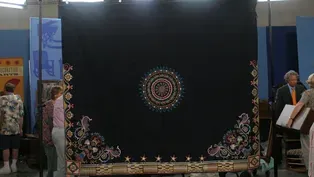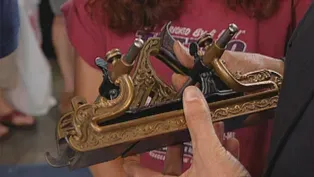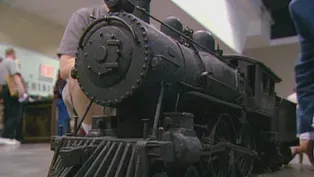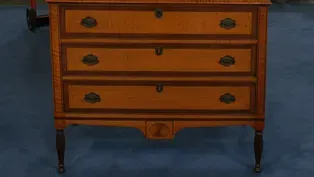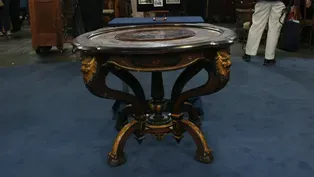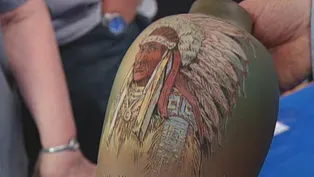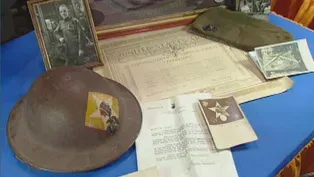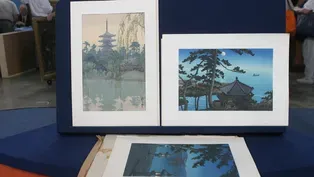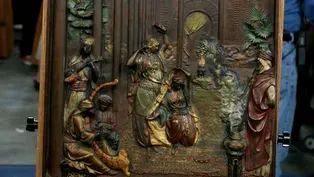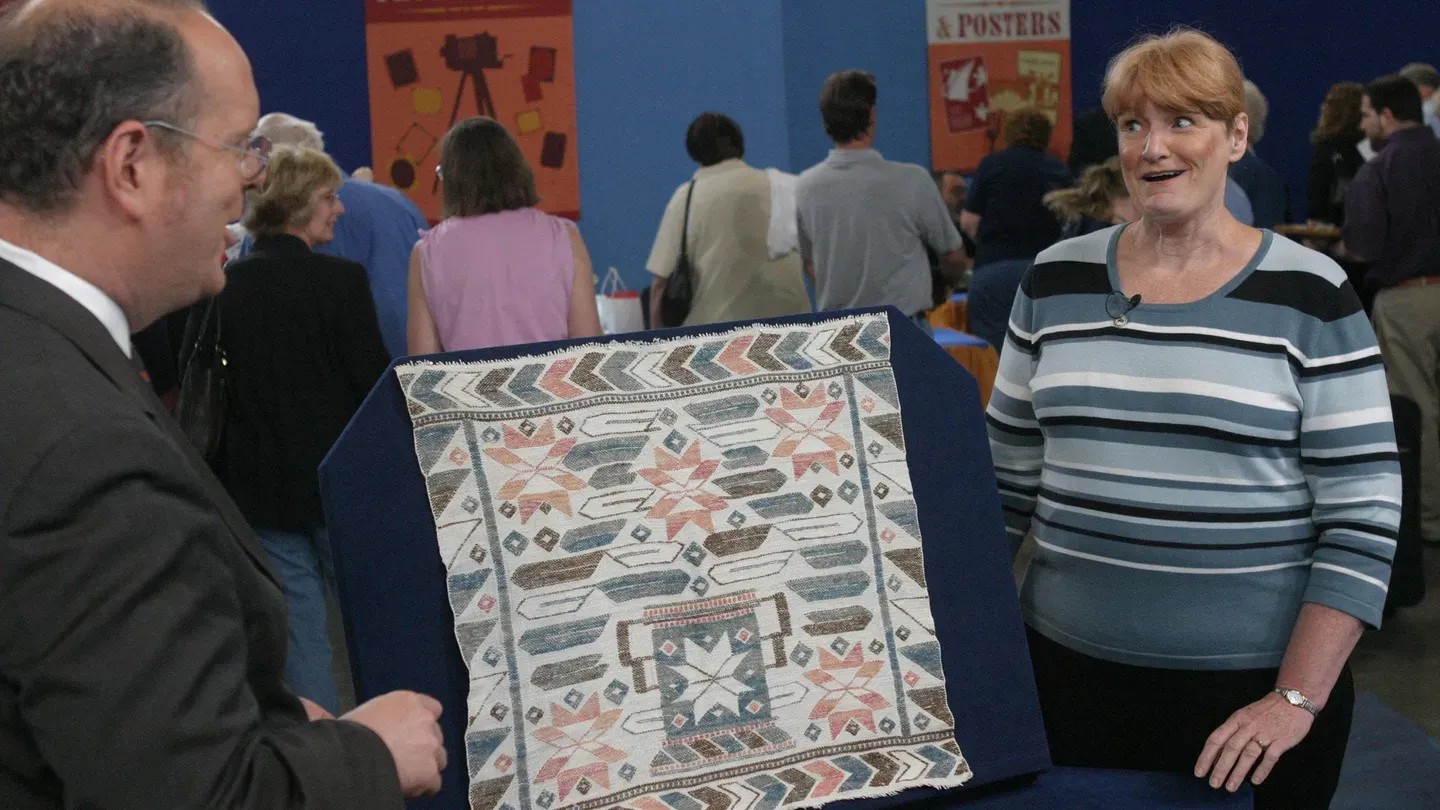

Vintage St. Paul
Season 23 Episode 16 | 52m 32sVideo has Closed Captions
Discover which marvelous Minnesota treasure has skyrocketed in the market to $2M – $3M!
Discover which marvelous Minnesota treasure has skyrocketed in the market since its original 2004 appraisal, and is now ANTIQUES ROADSHOW’s highest-valued treasure ever at $2,000,000-$3,000,000!
Problems with Closed Captions? Closed Captioning Feedback
Problems with Closed Captions? Closed Captioning Feedback
Funding for ANTIQUES ROADSHOW is provided by Ancestry and American Cruise Lines. Additional funding is provided by public television viewers.

Vintage St. Paul
Season 23 Episode 16 | 52m 32sVideo has Closed Captions
Discover which marvelous Minnesota treasure has skyrocketed in the market since its original 2004 appraisal, and is now ANTIQUES ROADSHOW’s highest-valued treasure ever at $2,000,000-$3,000,000!
Problems with Closed Captions? Closed Captioning Feedback
How to Watch Antiques Roadshow
Antiques Roadshow is available to stream on pbs.org and the free PBS App, available on iPhone, Apple TV, Android TV, Android smartphones, Amazon Fire TV, Amazon Fire Tablet, Roku, Samsung Smart TV, and Vizio.
Buy Now

ANTIQUES ROADSHOW 2025 Tour!
Enter now for a chance to win free tickets to ANTIQUES ROADSHOW's 2025 Tour! Plus, see which cities we're headed to!Providing Support for PBS.org
Learn Moreabout PBS online sponsorshipWhen this walked in, I was...
I was speechless.
It is truly a remarkable piece of history.
It is the Rolls-Royce of these.
My dad is smiling somewhere.
(laughing): It can't be.
APPRAISER: Yes.
No way!
♪ ♪ MARK WALBERG: When "Roadshow" visited Minnesota in 2004, we discovered one of our most valuable pieces to date-- this Patek Philippe pocket watch.
15 years later, will it take the crown of "Antiques Roadshow's" highest-appraised item?
We'll find out later on in the show, but for now, let's see if the values of these other Twin Cities treasures went up, down, or stayed the same in this fresh look at St. Paul.
MAN: This piece belonged to my grandmother.
She had a lot of antiques, but most of them were glass.
The kids in the family didn't get to go around those very often, but this one was always out on the floor, and so, as I grew up, this was a part of all the parties and Christmases there.
And when she sold her house, the grandkids and the kids could choose different things.
And this is the piece that I always wanted, so my name was on this one for a long time, so that was... And when did you actually get it?
About five years ago.
Well, let me tell you a few things about this wonderful piece.
We cannot find any maker in Ohio-- it says Ohio Stoneware-- with this maker, so this is a piece that we still need to do some more research on.
The fact that it says on the bottom "1876 Centennial," makes me speculate that it might have been used in the Centennial celebration in Philadelphia in 1876.
Wow.
The various states had exhibits.
And this might have been an example from an Ohio stoneware maker.
It's slip cup-decorated, with cobalt.
The cobalt was drizzled onto the stoneware before it was fired.
Wow.
And this wonderful bird is a peacock.
The writing and the decoration takes up the full palette, and that's what we in American folk art look for in a great piece of stoneware.
This is wonderful.
The date 1876, and it's a little miniature jug, which is a replica of the large jug.
And you told me how this handle got broke.
Yeah, my grandmother always said that she bumped it while she was vacuuming.
Well, I would just leave it the way it is.
It doesn't need any repair, and it really doesn't hurt its value.
If I had this at a show, I would have this priced at somewhere between $65,000 and $85,000.
(laughing): Are you kidding me?
No, I'm not.
Oh, my God!
I think it's an absolutely monumental piece of American stoneware.
Earlier, when I lifted it up here, you said you almost had a heart attack...
I did!
...when you saw me grab it by the handles... You were lifting it by the handles, which is just an absolute no-no for a small piece.
So never do that again.
I've moved that...
I've moved it a couple of times like that.
But I won't move it that way anymore.
WOMAN: I bought this poster at an auction about six or seven years ago.
APPRAISER: When you bought it at auction, how much did you pay for it?
I believe I paid about $350.
Do you know who the artist is?
Do you know when it's from?
Do you know what it's for?
(chuckles) I really don't.
I hate to admit my ignorance.
I understood that it was a theater poster.
It is a theater poster.
It's the Alcazar d'Été, which was one of the two great French music halls on the Champs Élysées, only during the summer.
There was also the Alcazar d'Hiver, which was the winter theater.
But these were outdoor music halls on the Champs Élysées, and this is a poster for a cabaret act for the four Marten sisters.
Okay.
I hate to tell you my ignorance.
I don't know who they are.
Their act is lost to history.
They are the tambourine-playing, dancing quartet.
But they were, obviously, a minor sensation in the Parisian music halls at the end of last century.
There's no date on it, but I went to some reference books, and I looked it up-- it's from 1888.
Oh, my.
Which is a really early lithograph.
But the more interesting thing to me is who the artist is.
Now, you don't see an artist's name anywhere on the picture.
It's unsigned, but it is clearly the work of Jules Chéret Now, Jules Chéret's name appears on the poster but not as the artist.
His name appears right here as one of the printers of the poster.
Jules Chéret was basically the father of the modern poster.
He's been called both the father of modern lithography, and the father of the modern poster.
And it was his work and his work alone that created the entire sensation of posters in Paris at the end of the 19th century.
He was the master of combining four colors into a virtual rainbow of lithographic colors.
Now, this poster pre-dates his really colorful images.
This is really only three colors, not four.
It's red, blue, and black.
And it's unusual, because Chéret's earlier lithographs are usually much smaller.
And in about two years after this, he began designing the posters that were really filled with yellows, filled with reds, filled with purples and greens.
But this is a very important early work of his.
It is valuable.
It is interesting.
It's a great document because it's an early work of this very important artist.
We decided that a very fair auction estimate would be $1,500 to $2,000.
Oh, my goodness.
And the great thing about auction is, if other people feel it's as rare as I'm telling you, then the price can only go higher.
Wow.
(laughs) So it really does have a lot of pizzazz.
Yes, yes, it suddenly has more interest to me.
That's great.
You saw the name H-A-N-D-E-L. Philip Handel worked in Connecticut.
The shade is an 18-inch chipped-ice shade.
The value of the lamp is $10,000 to $12,000.
Wow.
GIRL: I bought a illustrated historical atlas of the state of Minnesota.
It's 1874, and what they do is, they show, like, this is St. Paul, where we are now, but it shows all the buildings of St. Paul, all the streets, the river.
MAN: The person who got all these was my uncle.
He was in the 6th Marines, 2nd division, 78th company.
Okay, in World War I.
He's got the Purple Heart, he's got the Navy Cross, and the Distinguished Service Cross.
And those two are extremely high medals.
Those are just below the Medal of Honor.
Probably one of the greatest Marine groups I've seen from the World War I period.
APPRAISER: You didn't own this chair at 8:00 this morning.
Now you do-- what happened?
I was out driving around this morning, getting myself a cup of coffee, and I saw a garage sale.
So I saw the chair.
I thought it was old.
What'd you see about it that said it was old?
Well, I just felt the top here.
Okay, this stuff, okay.
It just felt nice, it felt old.
Okay, all right-- you looked under here.
I'm looking at the back here, I'm looking at this...
I'm looking at these through- tenons coming through the back.
Old color, right?
Yeah.
So how much was it?
Two dollars.
It was two dollars.
Yeah.
Two dollars, though?
Two bucks.
(laughs) Did you ask for a better price or anything?
No, no, I didn't.
Two dollars, this morning.
This morning.
Right here in town.
Yup.
This is incredible.
This is what keeps all of us out there looking, to have stuff like this happen.
Definitely.
This is a circa 1770 Chippendale Philadelphia chair.
Through-tenons are typical Philadelphia.
Through-tenons, these seat rails are coming through the back leg.
The original finish, this 200 years of grunge.
This pure splat is a wonderful splat.
I'm going to look inside here.
Can I rip this open?
Yeah, go ahead.
Are you sure?
Yeah, go ahead.
You only paid two dollars, so I'm going to...
This is just the scrim, so... And what you've got here-- look at this.
(straining): That's the original... That's the original yellow pine seat frame, 1770, same date as the chair, marked number two from the set.
Okay.
Look at this.
This is chair number one from the set.
You see that little mark?
Oh, okay.
So you got chair number one, seat frame number two, on a Philadelphia chair with an old finish for two dollars-- you know what it's worth?
I have no idea.
About, easily, $1,500, easily.
Wow.
Easily $1,500.
Another little touch, there's a name on the back.
Did you see this?
Mm-hmm.
This has an incised name.
"Foulke?"
Mm-hmm.
That's one of the oldest Philadelphia names.
This is probably an early owner that scratched their name on the back of the chair.
Fantastic.
Is that cool or what?
Yeah, I, I had no idea.
MAN: These were gifts to my mother.
They were given to her in 1957 in New Mexico.
She had worked for a senator from New Mexico by the name of Chavez, trying to strengthen the legal standing of Indians at the time.
So in 1957, when we took a road trip, we stopped at a household where the people's name was Tafoya, and these were given to her there.
Do you know who made these pots?
I know the name Marie on the bottom.
I had thought they were somehow connected with Tafoya.
The Tafoyas did know Maria and Julian Martinez.
The Martinez family lived at San Ildefonso Pueblo.
I believe the Tafoyas lived at Santa Clara, which was like across the fence, literally.
You said you saw black pots in the Tafoya household?
They were making some pots.
One of the kids there showed me how they polished the surface with the smooth stones from the gravel bed.
Right.
And the pots were red... Yeah.
before they fired them in these beehive-type ovens, and they showed me what it looked like coming out.
Yeah.
Which was this color.
What these are is Maria Martinez pots from San Ildefonso Pueblo.
Judging from the signature on the bottom, probably... late '20s, early '30s.
What this design is, it's the underwater serpent Avanyu, and it goes all the way around the pot.
This black on black is what's called a reduction firing, where they reduce the oxygen in the firing procedure, and it turns them black.
It's not a traditional Pueblo technique.
It's something that the Martinezes learned in the early '20s and became masters of it.
And now it's completely identified with that pueblo.
The signature's right on the bottom.
If you look here, it says "Marie."
It's done the right way, right time period.
They could use a little cleaning.
They've got some little abrasions, but nothing major.
What do you want this appraisal for?
Insurance.
I've got my two kids.
Whenever we're through with them, I'll give one to one and one to the other.
Well, let me first tell you that the value is, they're a pair.
They're the only matched pair of this size of Maria pots I have ever seen any time.
This is it.
This is the ultimate pair of Maria pots.
Huh.
The size is great.
The water serpent, they're exactly matched, not just a little matched.
They are exactly matched.
You want to be able to go out and buy some new ones if you break them?
You'd better start at $45,000 and go up to about $55,000.
Wow.
You're sure?
I'm positive.
I got on the telephone and called Santa Fe, and, yes, I'm positive.
No kidding.
Yeah.
I didn't have a clue.
These just have been sitting on the top of the bookshelf gathering dust.
Don't let them fall, okay?
(chuckling): All right, all right.
MAN: Well, the Millers uniform I located at a collectors' show about 20 years ago in Minneapolis.
I bought it for the price of $50.
So this is a Minneapolis Millers uniform.
This is a home uniform of the Millers, and it dates from 1950.
The Millers were a minor league team.
They were the American Association representative of Minneapolis in the Twin Cities.
There was another team, the St. Paul Saints, and we're equally as proud of their history, as well.
Now, this, this uniform is number 28.
And you had it for a long time before you figured out who number 28 was.
When I found out that Willie Mays wore number 28 in the 1951 season, I became very interested, and a little more curious about doing some background work on it.
Knowing that the uniform was from the preceding season, I began to do some forensics on it.
(chuckles) And there are particular details involving the lettering and the ribboning on the front of the uniform.
But a dead giveaway was this team repair.
Yeah.
On the right sleeve.
I see it right here.
And, amazingly, you found a photograph... Yeah.
Of the Say Hey Kid, pre-New York Giants, wearing this uniform.
Here he is in this picture right here.
Exactly.
Clear as day.
It's obviously a remarkable piece.
It's a remarkable story.
It's in immaculate condition.
That helps it.
You spent $50 on it.
I would estimate it, conservatively, in the $60,000 to $80,000 range today.
Oh, my.
Talk about goosebumps.
When this walked in, I was-- I was speechless.
It, it is truly a remarkable piece of history, and it just does not get any better than this.
WOMAN: It's a piece I found at a thrift store in Minnesota.
One of the things I always go for are linens, needlework of any kind, because it interests me, and I like just to study it and appreciate it.
I have a lot of appreciation for women who have done needlework, and this kind of stuck out at me.
APPRAISER: When I first saw this, I was thinking, "Well, we're in Minnesota.
"Of course I'm going to see a lot of kind of 20th-century Scandinavian-inspired textiles."
Certainly.
Which generally in the market today are of very little interest, because they're things that were either made in this country or were commercially made in Scandinavia.
And then as I looked more closely, I realized, but wait, this isn't just another one.
There is something more going on.
There's an incredible subtlety to the coloration and the way this is woven and put together.
We've got shading of different colors of roses, to fuchsia, and then blue-greens to blue.
And there's an artistry in this that you wouldn't just see in a common piece.
So I was thinking, "Gosh, you know, this really is better than most," and got intrigued myself.
And then, I recognized that in the corner, it was signed, which, most commercial pieces aren't signed.
And this is signed with the initials "MMF," which stands for a woman named Märta Måås-Fjetterström, who was probably the leading textile designer and producer in Sweden in the early 20th century.
Oh, no!
She started out as a painter, started a workshop by 1918, 1919, producing textiles, curtain fabrics-- all handmade-- also rugs and carpet.
I mean, she was of such prominence, that she designed and manufactured the rugs that are used for the Nobel Prize ceremonies in Stockholm, so she's really a designer of some note.
Typically in the market, we come across pieces of hers that are quite large.
I've never seen a handwoven, flat-weave textile of this size coming from her.
And the quality backs up with the initials.
Do you have any idea of what this may be worth?
Absolutely not-- I knew it was worth the dollar that I paid for it, just to have something to, you know, to study, because it was so interesting.
Right, because I would say, with the popularity of Märta Måås-Fjetterström things on the market today, because it's really coming on quite strong, I would place a retail value on a piece like this today of somewhere between $2,000 and $4,000.
(inhales, groans) Certainly worth a dollar investment.
Oh, my goodness!
WOMAN: It's my sister's chair.
She purchased it from some friends of mine in the late '70s.
After that, she was looking at an antique trader, noticed another chair in there called the Lost Treasure, and realized maybe she had a treasure of her own.
You and your sister both know this is a Gustav Stickley chair.
Yes.
Because it's marked, and we'll look at the mark in just a second.
Right.
Gustav Stickley is known for very scaled-down and simple, heavy furniture.
Well, this is not so scaled-down, because it's got this inlay decoration across the back.
Okay.
And it's also rather light, compared to a lot of his pieces.
The lines are a lot thinner, and the pieces of wood are a lot thinner.
That will tell you this is a special piece.
Harvey Ellis was a designer, he was an Englishman who worked for Gustav Stickley for not much more than a year.
He was an alcoholic, and he died in 1904.
Oh, my.
But he brought this rather decorative European Arts and Crafts style, and it modified Gustav Stickley's more severe look.
And so these inlays, which are on the back of these back slats, have inlays of pewter, copper, rare woods.
Now, your sister mentioned there was some repair to the inlay?
Right.
Could you point that out for us?
I believe she said this one was a repair, and possibly a crushed-up penny that was put in there.
It was just kind of flattened out and banged into place.
Flattened-out penny, yeah.
That's not unusual.
It's not the end of the world when that occurs.
We know it's an early chair because Harvey Ellis died in 1904.
There are other ways we know it's an early piece of Gustav Stickley furniture.
Okay.
If you look inside the chair, you see these holes?
Yup.
This had a cane seat foundation that a cushion would rest on.
Later pieces of Gustav Stickley would have drop-in seats or spring seats.
Furthermore, this piece has an earlier mark on it, which we'll look here.
It's inside of a box, so it's a decal.
And these early pieces were often marked under the arms, but when you see a box around the mark, you know it's an earlier piece of furniture.
Another indication that it's early is this finish, which is really beautiful.
And it makes a huge difference in the look, the quality, and the value of the chair.
See the difference of the color between the back of the arm and the bottom of the arm?
Yup.
That's because of normal wear, people putting their elbows and arms, and wearing down the color.
That's not a bad thing.
It shows this chair has not been cleaned.
If anybody refinished this chair, they would have evened out the color on the arms.
Okay.
But if we turn the chair around...
The color on the back is this rich, chocolatey-brown fumed finish.
It's really what you want to see on a Harvey Ellis chair and makes a vast difference in price.
Condition overall, it's a little loose, a little inlay replacement, nicks and dings here and there, but otherwise in fine condition.
Retail, today's market for this chair, $40,000 to $50,000.
Oh, my word.
That's awesome.
Several things would make it worse less.
If this had a lighter...
If it was refinished, $10,000 to $15,000.
Lighter finish, $25,000 to $35,000.
With this color, this is stone-cold retail, but retail is $40,000 to $50,000 for this chair.
Oh, my word-- that's awesome.
This is a piece of Weller pottery from the Zanesville, Ohio, area.
And it's a line called Dickens Ware.
This beautiful portrait of a Native American happens to be Little Wound.
Condition is really nice.
The artwork is exceptional.
APPRAISER: It was built as a model, and they're so different, because they're sort of folk art in a way.
This one is mostly of wood.
It looks like it's had a little overpainting at some point.
That might hurt the value a little bit.
It's a very accurate model, and it's five feet long.
APPRAISER: This is probably the Holy Grail to tool collectors.
I can't think of any tool that Stanley collectors are more excited to find.
It's a Miller's Patent Plane in gun metal.
When I saw it today, I was, like, "Yes!
"Yes!
The Miller's Patent Plane!"
WOMAN: It's about 1920.
My mother bought it.
She bought it at a showing in a art shop in Rockford, Illinois.
She paid $2,000 for it.
APPRAISER: And the artist is?
Robert Blum.
It's actually pronounced Robert "Bloom," even though it doesn't have an E. Oh, really?
Okay.
It may be that she bought it in the Midwest because he was from the Midwest.
He's from Cincinnati, Ohio.
As you rightly said, it desperately needs to be cleaned.
You can see the sky is very brownish here, and it would be a nice blue if it were cleaned.
And it has a touch of paint loss down here.
But I think in spite of all that, you have a wonderful work.
It's pretty much in original condition.
And this artist is fairly rare.
He doesn't come up at auction very often.
So I think all in all, you might want to insure it for something like $125,000.
Wow.
A little more than $2,000.
Super-duper.
Yes.
WOMAN: It was willed to my mother by a relative that she didn't really like very well, who was a career woman in the '30s and '40s, and a registered antique dealer and appraiser.
And when Della died, this thing came to the house, and my mother looked at it, and she said, "That's ugly.
I don't want it in the house."
And I think it was because she didn't like the person who had given it to her.
Of course.
So she had them keep it in the garage.
And a week later, an appraisal came with it that was for $5,000, in 1948.
Okay.
And at $5,000, she thought maybe it could find a place in the house.
When we looked at this yesterday when it was brought in, we couldn't quite figure out where it was made.
It's a great mystery.
And I've done a lot of research.
I stayed up most of the night trying to think about your piece of furniture.
Great!
And I think I've come up with an answer.
Now, have you ever looked at the back of this piece of furniture?
Um, I don't know if I really have.
Well, we did some detective work last night, and there are two paper labels on the back.
And they have the name "Hearst" on it.
Okay.
Have you ever heard of William Randolph Hearst?
Yes, yes.
Well, he was a great antiques collector and really the founder of the Hearst empire.
And at the time of the Depression, he lost most of his money, and his antiques collection was sold at Gimbels department store.
And there are two labels on the back of this piece of furniture that say "Gimbel."
And as we started to look at it, these shells are inlays.
They were probably imported from Great Britain and put on this piece by the cabinetmaker.
That was a clue that it probably was made in a coastal town.
Then we further looked at it, and as you open the lid here-- this is what's known as a cylinder lid.
It resembles what's known as a tambour, which is where each piece, almost like toothpicks, slide back with canvas supports underneath.
But this is a faux tambour, because it's all one piece, carved to look like a tambour.
And you have the tiger maple interior.
But then you pull this board out here.
A beautiful bit of cabinetmaking.
Now, what kind of wood is this, do you know?
I assumed the whole thing was maple.
This is birch.
Okay.
And birch, the country cabinetmakers called "mountain mahogany," because it would talk a stain that resembled mahogany.
Most people today can't tell the difference if it's properly stained.
Okay.
With this, I started to do some research.
And there are a couple of advertisements for a cabinetmaker in Saint John, New Brunswick, by the name of Thomas Nisbet.
And two advertisements, the first one is that he needed to buy 8,000 to 10,000 feet of birch for his cabinet shop.
Okay.
And the other one said that he had just imported some of the finest mahogany from Jamaica.
You have a little bit of Jamaican mahogany here.
Now, Nisbet was born in Scotland.
He trained as a cabinetmaker, and came to Saint John, New Brunswick, in 1813.
Did he bring these inlays with him when he came from Scotland?
Because these were certainly not made on this side of the pond.
Okay.
So in my opinion, this piece could certainly be from Saint John, New Brunswick, and one of the finest pieces of cabinetmaking.
I am going to give you a figure of $50,000.
Oh, that's amazing.
APPRAISER: This was made by your great-great-grandmother?
Is that correct?
WOMAN: That's correct.
Two greats?
And her name was?
Jane Dixon LaFramboise.
And she was married to Joseph "La-fram-bwa"?
Yes, that's the French pronunciation, yes.
The French pronunciation?
And we know that he was an interpreter to the Sioux.
Yes, and he was a fur trader.
He came here from Mackinac Island.
Your great-great-grandmother, she was Sioux, do you believe, or do you know?
Yes, as far as we know, she was part-Ojibwe, part-Sioux, and about a quarter-English.
Do you know what this object is?
Well, it's called a blanket.
For a time it was in the museum at Sleepy Eye, loaned to them by a granddaughter of hers, and then it was given back to my mother later.
And the card they put it on it, they called it a blanket.
It is a blanket.
It's a woman's blanket, and it's a woman's shawl, or dance blanket.
Oh!
And it is the best one of these I have ever seen in my life.
It is the Rolls-Royce of these.
Now, we know Joseph LaFramboise died in 1856.
That's correct.
Your great-great-grandmother died, do you know when?
About 1885.
Well, I suspect she made this before her husband died.
Yes, I think during their marriage.
I would date this around 1840.
Mm-hmm.
It's all trade material.
All of the material here was got through the fur trade, trading furs for the beads, trading furs for the blanket, for the silk.
Okay, okay-- okay.
It has stunning silk appliqué work most of the way around the outside border.
Beautifully designed, in terrific condition.
The color preservation is still quite good, given how old it is.
Yes.
These blankets are generally made by the Osage tribe, which are related to the Sioux.
This is a Sioux variation.
The Osage just did this ribbon work-- looks slightly different-- without doing the bead work.
Oh.
And what really makes this blanket for me is this bead work.
Extraordinary sense of color.
Your great-great-grandmother was extremely talented.
This center medallion here is so beautiful.
That's my favorite part-- I love the center.
The stars across the bottom.
Normally, there's no bead work on these at all.
Normally, they're 50 years newer.
Normally, they don't look anything like this at all.
It is fantastic.
There's a little bit of condition problem here.
Yes, sure.
We can see where there's probably moth damage.
Sure.
Really needs to be conserved.
I think conservatively, somewhere between $60,000 and $75,000 for this.
Well, I don't think they can have it.
Good for you.
WOMAN: Well, this is a Margaret Bourke-White photograph, and my father commissioned her to photograph for him the complete steelmaking process.
He was chief metallurgist for Republic Steel.
APPRAISER: When we look at fine art photographs, documentary photographs, by masters of photography like Bourke-White, we recognize that they used certain papers and had certain trademark styles over and over again.
This black-ruled border that we see around the print is typical of how she created her photographs.
The other thing that is typical of a Bourke-White image is this cream-colored, double-weight paper.
It has a slightly pebbly finish to it.
It has a real heft.
And that, too, gave me a clear indication.
The final, and of course most important part of this picture or puzzle is the subject matter.
Yes.
Now, talk to me a little bit about what this depicts.
Well, it's one process of about 15 or 20 that she made for my dad that show from the very beginning, where they charge the blast furnace, all the way through to the ingots that are being rolled on the ingot floor.
And so I'm not sure what's going on here.
Right.
I just know it's part of that steelmaking process.
It epitomizes the industrial age.
Yes.
The modernist period.
And, of course, later on, in the mid '30s, in the late '30s, Bourke-White became synonymous with abstract modernist photographs, very much like this, sometimes a little bigger, that also depict the ideal machine.
Oh, yeah.
And this was part of the graphic language associated in the United States with the modernist vocabulary.
In the auction market, I would estimate this picture at $4,000 to $6,000.
The one print?
The one photograph.
But there's a whole series of them in my brother's attic or basement or... Well, that sounds even better.
And some of the photographs are bigger and some are...
The one that shows the ladle pouring the molten steel is the largest.
I mean, it was outsized.
The rest are all this size.
APPRAISER: There's the William Moorcroft mark that was signed by the original manufacturer.
What's unusual about this, also, this was retailed by Tiffany.
WOMAN: That is so neat.
Wow.
It's an instrument called a cimbalom.
It originally was invented in Hungary.
It's made, as you can see, 1890, in Minneapolis.
APPRAISER: This is called a Bakelite cherry pin.
And Bakelite was patented in about 1908, and it was a very durable plastic, and today, it's very collectible.
APPRAISER: On first look, what we have is a regular Civil War soldier's letter home.
But on closer look, it's a hand-drawn map of the vicinity of the Battle of Lookout Mountain in Chattanooga, Tennessee.
I believe you said you know the soldier that drew this.
WOMAN: Yes, it was my husband's great-grandfather, and he was a surveyor and an engineer.
Really?
And an artist, as well.
He did a wonderful job.
Yes.
He drew in the Lookout Mountain.
And what I loved about it is, on the right side, it says, "Enemies retreat to Chickamauga," which was the next stage of the battle in the campaign for Atlanta.
This is wonderful because the size is perfect, the detail beautiful.
The last one of these I sold similar to this brought $1,000.
Wow.
But it's a wonderfully drawn piece of Civil War history.
MAN: Well, I know they're Schoenhut, and I found them at a farm auction in Wisconsin about, oh, eight, nine years ago.
I have never seen another set of them.
It was a box that looked like junk.
APPRAISER: Uh-huh.
And I bid five dollars on it.
And that's what I got it for.
Well, what do you think they're worth?
I would say they're maybe worth about $100 apiece, pricing out some of the other Schoenhut items.
It's the Schoenhut Humpty Dumpty Circus, which was made by the Schoenhut Company in Philadelphia.
A lot of people think Schoenhuts were made in Germany, because it's a German name.
But they were made in Philadelphia, starting in the 1890s.
And the circus was made well into the early '30s.
We've had pieces of the Humpty Dumpty Circus before on the "Roadshow," some of the animals.
Yeah.
And of course, I've always considered this Humpty Dumpty Circus the... one of the first play set toys ever made in America, and one of the great classic American toys, because it allowed the child to recreate that fantastic circus.
Probably one of the most rare components of it is the band.
The band.
You absolutely made a fabulous find.
And this felt is almost perfect.
Usually, these are moth-eaten.
Now, they're a little dirty.
All these pants could be cleaned up.
You're missing a helmet here or there.
Yeah.
Of course, you see this fella here with the bent limbs?
You know why he was able to sit down?
He was usually on top of a bandwagon.
Yeah, he was the driver of the bandwagon.
But it's an absolutely fantastic set and very, very hard to find in pretty amazing condition.
In today's market, I would value this set at easily $10,000 to $12,000.
Great.
So...
I'm very pleased.
I think you did... you did very well.
I did very well.
WOMAN: This was my father's guitar.
He was a sign painter by profession, but he had a passion for music, and he grew up in a family that had a lot of music in the home, and he played many instruments.
He always aspired to have an electric guitar from, I think, the time they probably were invented.
And this was his pride and joy.
It's been sitting underneath my bed for... Really?
...since 19... you know, '86.
And I let my son play with it when he was young, and there was a tremolo bar on there, and I think he somehow or other lost that along the way.
It's a Fender Stratocaster.
It was made in 1957.
I'm going to pick up the guitar so we can start off with the back.
It's a maple neck, which was made up until 1958, and this is what they call a skunk stripe.
The other thing that lets you know that it's a '57 is that it's a two-tone sunburst.
This finish, instead of being black to red to yellow is black to yellow.
It's a non-laminated plate over the tremolo area on the back.
I'm going to turn it around.
And on the front of the guitar, you can see the neck has a maple fingerboard.
I took the neck off earlier, and inside of here, there's a date of 8/57.
And that matches with everything else that I saw on the guitar before I did this.
So it made me feel comfortable in thinking it is that.
This pick guard is right for the year.
It's a non-laminated white pick guard with screws that don't look like they've really ever been off.
All the parts, the colors, the patina of everything that I see looks right, looks really original, looks really nice.
The tremolo bar, which would go in here, is replaceable.
You can find that part.
Has anyone given you any idea about the guitar as far as its value?
Not at all, no.
I ran across a magazine that told me I probably should be taking care of it, so that was all I did.
Do you have any idea?
The range in the magazine said it could be as high as, like, $3,000.
I feel real comfortable in thinking that the value is significantly more than that.
I would guess somewhere in the neighborhood of $15,000 to $17,000.
It's a nice thing.
You're very lucky.
Oh, my gosh.
Oh, my dad is smiling somewhere.
So... (laughs): That's terrific.
WOMAN: I got this piece from my great-grandmother.
It came to me by her son to my uncle and then to me.
I really thought it was unusual and pretty and feminine, and it spoke to me.
APPRAISER: It's a sweetmeat jar, which is basically for candies.
What you have here is a piece of Mount Washington glass.
This glass was designed by Frederick Shirley of Mount Washington Glass.
Mount Washington Glass eventually was bought out by Pairpoint Glass.
And this would have been about 1884.
Oh, my gosh.
So it's an early piece.
Wow!
And this intrigued me when I saw it-- this pattern.
And I was thinking it was octopus.
But it's a starfish.
Oh!
And it's all the way around.
We have three sections of jeweled area of starfish.
Under this is a hobnail.
It's hard to see, because it's blended into the glass, but it is considered hobnail.
Oh, wow!
This used to be called Albertine glass, but now it's commonly called Crown Milano.
The lid and the bail handle, that's silver plate.
If you're able to get this cleaned up, this is a comfortable piece at $2,000.
(gasps) (laughing): You're kidding!
If you...
If you, if you can't clean it up, then you might have to have a professional do a little re-silvering.
You might have to spend a little money to bring it up to that $2,000.
Okay, yeah.
Oh, my gosh!
It's a wonderful, wonderful piece.
It is!
WOMAN: We got these from my aunt, and she was in Japan in 1956.
She was a civilian working for the military, and so she brought quite a few of these woodblock prints and other Japanese items back.
The prices ranged from $1.25 to about four dollars apiece.
You've got a number of prints by two different artists.
The first artist is Hiroshi Yoshida.
Was a Japanese artist born in the late 1880s, lived to the 1950s.
And he was noted for producing these very atmospheric, beautiful woodblock prints.
Each color that you see here is produced by a separate block of wood that's been carved, used only for that specific ink.
Wow.
So a single print like this might have as many as a dozen or more separately carved blocks of wood, each with the same scene.
Now, what makes this extraordinary is that every block of wood has to be applied in exactly the same register.
Otherwise, the lines are off.
And Yoshida was one of the great printmakers.
And we know this is by Yoshida, not only because of the style, but when you open it up, you can actually see he signed it there, and here's his Japanese signature.
He broke with the past and entered into the 20th century in his designs.
So you very much have a modern aesthetic.
These landscape views that are very evocative of early times.
Here's an alley of wonderful trees, and you have these marvelous kind of sunsets.
And then he's also known for nighttime scenes.
The other artist who worked at the same period of time is Kawase Hasui, very much the same style, because both of these artists were bringing woodblock prints into a modern, 20th century aesthetic.
And you can see his signature right over here on this side.
And it describes this moonlit scene.
And I'm not going to lift all these prints up, but you can get a flavor of the workmanship, and the beautiful, bright colors are so important.
So what's happened with your aunt when she had these is, she was very careful about keeping them in a closed container, so the colors are fresh, and vibrant, and just like they were when they were new.
Now, she paid, you said, $50 for the entire group.
Right.
For insurance purposes, the values would range from $2,000 to $3,000, maybe even $4,000 each.
(laughs) (laughs) Oh, wow!
If you were to sell them, it would be somewhat less than that.
Mm-hmm, insurance...
But, you know, you're looking at-- we just showed a few of these... Mm-hmm.
The group has easily got to be $20,000 to $30,000.
Really?
For insurance purposes.
Oh, my little aunt.
(laughs) So your aunt did a good thing.
Did you ever notice any... notice the maker's name on it?
No.
Okay, well, it actually is signed right here.
It's François Linke, who was a French furniture maker, active from I think about 1882 to 1935.
APPRAISER: This is Rookwood pottery, and it's dated 1881 and signed "MLN."
"MLN" is for Maria, or "Mariah," Longworth Nichols.
And she was the originator of the Rookwood Pottery.
The thing about early Rookwood-- which this is early, this is the second year they were in business-- it tends to be a little on the derivative and uninteresting side.
It's extremely organic.
It's really weird, not terribly attractive, but rather important.
This is Chinese Rose Medallion porcelain.
It was made for export to the West, and made very close to the middle of the 19th century, 1840 to 1860.
WOMAN: It belonged to a cousin of my father's.
And she came from New Hampshire.
And she died in 1955, at the age of 98.
And I assume that it's a relative, probably maybe her grandmother?
The piece is very distinctive, and it was done by a gentleman by the name of James Sanford Ellsworth.
And he was a miniature portrait painter that basically operated in New England, primarily in Connecticut and western Massachusetts right at the time of about 1840, 1850.
And this one is one of the best ones I've ever seen.
I would put a value on this of somewhere in the $5,000 to $8,000 range.
Oh, thank you.
My dad bought these at an estate sale, probably in the late '60s, from an elderly couple that were friends of theirs.
And they had purchased them in Italy.
When I did a little research on them, I found they were made by a designer named Gio Ponti in the early '20s.
He'd been trained as an architect, and this was his first real job.
When he was asked about this period of his life, he felt he was a failed architect and that he was just a draftsman now.
So these were his draftings.
When doing these, he did work for the Richard Ginori ceramic manufacturer.
And I will show you a mark on the back.
This is made in Italy.
And these have a wonderful, very modern, very industrial look to them.
They're extremely exciting.
Even something like this, which is in black and white, is so strong graphically.
The way these are decorated, these are partly transfer-printed, but they're also painted by hand over that.
Now, he did these designs for many different medium.
He did plates, he did vases, and he did tiles.
Now, we have had several tiles-- much smaller, eight-inch tiles-- go from $550 to $1,500 a tile.
Large ones like this, which are so rare and so fabulous, easily $5,000 apiece.
Oh, no, really?
Easy.
Wow.
WOMAN: I brought a doll that belonged to my grandma.
She lived in Le Mars, Iowa, and the doll came from an old woman who lived in the neighborhood.
Her name was Mollie Door, so we always referred to it as Mollie's doll.
Mollie was born in 1865, and it's from her childhood, we believe, and it's all the original clothes.
Right, and where was she from?
Mollie was from Galena, Illinois.
Her mother was from Germany, and her father was from France.
Very nice doll.
It's a German china doll, completely all original ethnic clothing, original wig.
Lovely, lovely face, nice shoes.
It's from probably early 1850s, maybe as late as 1860.
And not very many of these dolls show up.
Most German chinas have molded hair, painted eyes, and normal child-type clothing.
This is completely all original.
It's very, very rare to find a German china with glass eyes.
Some French chinas later on had glass eyes but not German chinas.
Another rarity on this doll, this doll's eyes actually sleep.
If you turn her around here, her eyes move.
She's got a leather body, wooden arms and legs.
And did you ever have her valued at all?
Grandma had her appraised in the 1960s, and they wanted to offer her, like, $400 for it.
Okay, $400 in the '60s was, you know, quite a lot of money.
Dolls were bringing $100, $200, $300, so somebody was probably being very fair then.
On today's market, she's gone up a little bit.
I mean, the last one I saw like this, much smaller, sold for $4,000.
Yours is probably in the $4,000, on maybe a really good day, maybe up to $6,000.
Wow.
Lovely little blanket-- now, what's with the blanket?
It was just one of her doll blankets that I wrapped it in.
Okay, so it's sort of, beautiful early American blanket, from again, the 1860 period.
Oh, really?
And the value of that is probably $200, $300.
Oh, really?
MAN: This watch was handed down from my great-grandfather.
He was the owner of the "St. Paul Pioneer Press and Dispatch" back in 1914, when he received this watch.
And it was handed down from him to my father, and then he gave it to me.
It's manufactured by the Patek Philippe Company of Geneva, Switzerland.
This is a photocopy of the original warranty depicting some of the complications of this watch.
The front of the watch has the hour and minute hand and the second hand.
It also has a split chronograph, so you can time two things.
It also has a minute register for the chronograph.
Off to the side is a slide for chiming the watch.
It's called a minute repeater, where you lift up the slide and it'll chime the time to the minute.
Okay.
When we flip the watch over, you have the day, the date, and the month, along with the moon phase.
It's also a perpetual calendar, which adjusts for leap year.
I'll be damned.
It's a very complicated watch.
In excellent, excellent condition, with the original box.
It also has two extra main springs and an extra crystal underneath.
Okay.
It has the original crystals and original 18-karat gold engine turn case.
Have you had any appraisals?
I had an appraisal done probably 15 years ago.
They told me at that time it was probably worth about $6,000.
They were a little low.
(chuckling): Were they?
Yes.
Patek Phillipe is now purchasing those watches for their museum.
This watch, at auction, I suspect would bring close to a quarter million dollars.
(laughing): No.
Yes.
A quarter million?
This is one incredible watch.
I've never held a watch like this in my hand.
What?
You're kidding.
That is one incredible watch.
(laughing): It can't be.
Yes.
No way.
It is an incredible watch.
Oh, I can't believe it.
(laughs) It's the finest watch I've ever held in my hand.
Are you serious?
I've never seen anything like it, other than photos.
Oh, my gosh, how do I get it home?
(laughs) Carefully.
Do not drop it.
That is unbelievable.
Keep it in a safe deposit box.
Well, that's where I have had it all this time.
Good.
But I... oh, my gosh.
That is incredible.
WALBERG: You're watching "Antiques Roadshow: WALBERG: And now, it's time for the Roadshow Feedback Booth.
I thought this was a fake.
And she said it was real, and she was right, and I'm really happy.
Me, too.
Hey, we are at Antiques Roadshow, and it rocks!
We brought in this lamp.
How much did we pay for it?
Five bucks.
Cool, and it's worth beaucoup dineros.
This place is awesome.
Whooo!
This was a great experience for me as a young person, and in 60 years, I'm going to come back and find out how much this poster is still worth.
(blows hoarse note) (laughs) Anyway... We had a great time.
One of the things I brought in today was this hand-made turquoise necklace.
I've learned that it was from 1910.
Although it's not an undiscovered treasure, I had a great time.
Maybe I should keep playing the Powerball, though.
I had a wonderful time.
I never miss this show.
I tell all my neighbors and family, "Please don't call me while 'Antiques Roadshow' is on."
If my house burned down, I probably would just take my TV outside and finish watching.
We came to the show hoping that we would be able to pay off our college loans with our great-grandpa's walking stick.
No.
No.
I just wanted to welcome the Antiques Roadshow... (in local accent): ...to "Minnesota."
And I was wondering if you heard any "ooh, yeahs" or "you betchas."
The Antiques Roadshow was a heck of a good time.
You know, you betcha.
WALBERG: I'm Mark Walberg.
Thanks for watching.
See you next time on "Antiques Roadshow."
Appraisal: 1863 Chattanooga Hand-drawn Map
Video has Closed Captions
Clip: S23 Ep16 | 57s | Appraisal: 1863 Chattanooga Hand-drawn Map (57s)
Appraisal: 1874 Minnesota Illustrated Historical Atlas
Video has Closed Captions
Clip: S23 Ep16 | 25s | Appraisal: 1874 Minnesota Illustrated Historical Atlas (25s)
Appraisal: 1876 John Alexander Stoneware Cooler
Video has Closed Captions
Clip: S23 Ep16 | 2m 23s | Appraisal: 1876 John Alexander Stoneware Cooler (2m 23s)
Appraisal: 1881 Rookwood Pitcher
Video has Closed Captions
Clip: S23 Ep16 | 28s | Appraisal: 1881 Rookwood Pitcher (28s)
Appraisal: 1914 Patek Philippe Pocket Watch
Video has Closed Captions
Clip: S23 Ep16 | 2m 47s | Appraisal: 1914 Patek Philippe Pocket Watch (2m 47s)
Appraisal: 1929 Margaret Bourke-White Photograph
Video has Closed Captions
Clip: S23 Ep16 | 2m 44s | Appraisal: 1929 Margaret Bourke-White Photograph (2m 44s)
Appraisal: 1951 Willie Mays Millers Jersey
Video has Closed Captions
Clip: S23 Ep16 | 2m 20s | Appraisal: 1951 Willie Mays Millers Jersey (2m 20s)
Appraisal: 1957 Fender Stratocaster Guitar
Video has Closed Captions
Clip: S23 Ep16 | 2m 28s | Appraisal: 1957 Fender Stratocaster Guitar (2m 28s)
Appraisal: 20th-Century Bakelite Cherry Pin
Video has Closed Captions
Clip: S23 Ep16 | 21s | Appraisal: 20th-Century Bakelite Cherry Pin (21s)
Appraisal: American Cimbalom, ca. 1890
Video has Closed Captions
Clip: S23 Ep16 | 21s | Appraisal: American Cimbalom, ca. 1890 (21s)
Appraisal: Chinese Rose Medallion Porcelain Bowl, ca. 1850
Video has Closed Captions
Clip: S23 Ep16 | 23s | Appraisal: Chinese Rose Medallion Porcelain Bowl, ca. 1850 (23s)
Appraisal: Chippendale Side Chair, ca. 1770
Video has Closed Captions
Clip: S23 Ep16 | 1m 54s | Appraisal: Chippendale Side Chair, ca. 1770 (1m 54s)
Appraisal: François Linke Side Table, ca. 1910
Video has Closed Captions
Clip: S23 Ep16 | 20s | Appraisal: François Linke Side Table, ca. 1910 (20s)
Appraisal: German China Doll & Blanket, ca. 1855
Video has Closed Captions
Clip: S23 Ep16 | 2m 10s | Appraisal: German China Doll & Blanket, ca. 1855 (2m 10s)
Appraisal: Gio Ponti Ceramic Plaques, ca. 1930
Video has Closed Captions
Clip: S23 Ep16 | 1m 47s | Appraisal: Gio Ponti Ceramic Plaques, ca. 1930 (1m 47s)
Appraisal: Handel Lamp, ca. 1915
Video has Closed Captions
Clip: S23 Ep16 | 28s | Appraisal: Handel Lamp, ca. 1915 (28s)
Appraisal: James Sanford Ellsworth Miniature, ca. 1850
Video has Closed Captions
Clip: S23 Ep16 | 52s | Appraisal: James Sanford Ellsworth Miniature, ca. 1850 (52s)
Appraisal: Meiji Period Cloisonné Charger
Video has Closed Captions
Clip: S23 Ep16 | 1m 2s | Appraisal: Meiji Period Cloisonné Charger (1m 2s)
Appraisal: Mt. Washington Sweetmeat Jar, ca. 1884
Video has Closed Captions
Clip: S23 Ep16 | 1m 57s | Appraisal: Mt. Washington Sweetmeat Jar, ca. 1884 (1m 57s)
Appraisal: Robert Blum Painting, ca. 1885
Video has Closed Captions
Clip: S23 Ep16 | 1m 8s | Appraisal: Robert Blum Painting, ca. 1885 (1m 8s)
Appraisal: Schoenhut Circus Band, ca. 1910
Video has Closed Captions
Clip: S23 Ep16 | 2m 4s | Appraisal: Schoenhut Circus Band, ca. 1910 (2m 4s)
Appraisal: Sioux Woman's Dance Blanket, ca. 1840
Video has Closed Captions
Clip: S23 Ep16 | 3m 2s | Appraisal: Sioux Woman's Dance Blanket, ca. 1840 (3m 2s)
Appraisal: Stanley Miller's Patent Plane, ca. 1880
Video has Closed Captions
Clip: S23 Ep16 | 21s | Appraisal: Stanley Miller's Patent Plane, ca. 1880 (21s)
Appraisal: Steam Locomotive Model, ca. 1890
Video has Closed Captions
Clip: S23 Ep16 | 24s | Appraisal: Steam Locomotive Model, ca. 1890 (24s)
Appraisal: Tiger Maple Secretary, ca. 1813
Video has Closed Captions
Clip: S23 Ep16 | 4m 1s | Appraisal: Tiger Maple Secretary, ca. 1813 (4m 1s)
Appraisal: Victorian Table, ca. 1865
Video has Closed Captions
Clip: S23 Ep16 | 34s | Appraisal: Victorian Table, ca. 1865 (34s)
Appraisal: Weller Dickens Ware Vase, ca. 1910
Video has Closed Captions
Clip: S23 Ep16 | 26s | Appraisal: Weller Dickens Ware Vase, ca. 1910 (26s)
Appraisal: William Moorcroft Pottery, ca. 1910
Video has Closed Captions
Clip: S23 Ep16 | 21s | Appraisal: William Moorcroft Pottery, ca. 1910 (21s)
Appraisal: WWI U.S. Marine Corps Collection
Video has Closed Captions
Clip: S23 Ep16 | 27s | Appraisal: WWI U.S. Marine Corps Collection (27s)
Appraisal: Yoshida & Kawase Hasui Prints, ca. 1925
Video has Closed Captions
Clip: S23 Ep16 | 3m 5s | Appraisal: Yoshida & Kawase Hasui Prints, ca. 1925 (3m 5s)
Appraisal: Vienna Bronze Plaque, ca. 1910
Video has Closed Captions
Clip: S23 Ep16 | 1m 3s | Appraisal: Vienna Bronze Plaque, ca. 1910 (1m 3s)
Providing Support for PBS.org
Learn Moreabout PBS online sponsorshipSupport for PBS provided by:
Funding for ANTIQUES ROADSHOW is provided by Ancestry and American Cruise Lines. Additional funding is provided by public television viewers.


